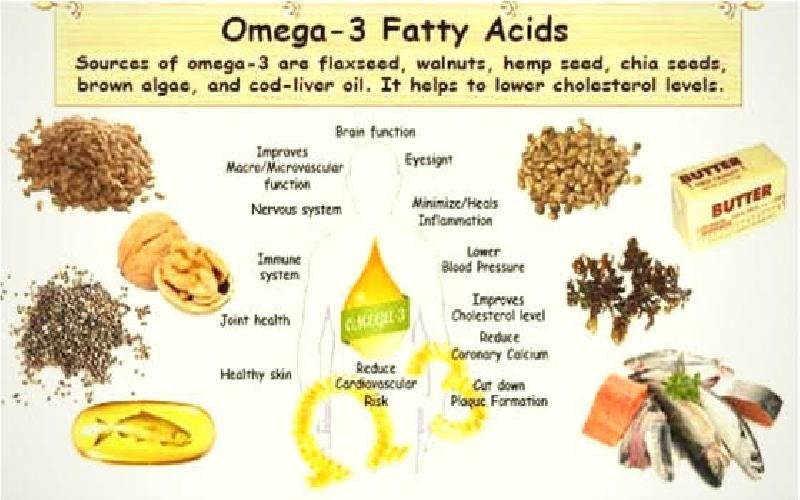Foods Rich in Omega 3 Fatty Acids


Omega 3 fatty acids are the building block of your body. There are hundreds of foods that are high on Omega 3 acids. People often wonder how to get their omega 3 daily supply. Just go to your nearby grocery store and shop for these foods that are hihgly rich on Omega 3 fatty acids and can fulfill your daily requirement. Just have a look at list of those foods.
a) Walnuts: Omega 3 by the Handful
Add walnuts to your morning bowl of cereal or your snack-time trail mix—excellent sources of alpha-linolenic acid (ALA). ALA is one of 3 omega-3 fatty acids and found mainly in plants. Many other nuts have some ALA, but almonds don’t.
b) Enhanced Eggs
Enhanced eggs with omega 3 can be found at many stores or farmers markets, but only the yolk has the omega-3 fatty acid, DHA. Egg whites don’t have these fatty acids. Eating these eggs for breakfast can give your day a start with healthy benefits of omega-3s to protect the heart and lower the risk of memory loss.
c) Fish: An Excellent Source of Omega 3
The two fatty acids, DHA and EPA, closely linked to heart health, can be found in cold-water fish. The American Heart Association (AHA) recommends 2 servings weekly of salmon, tuna, herring, lake trout, sardines, or other fatty fish. This is because omega-3s, DHA and EPA, lower triglycerides—the fats in your blood leading to blocked arteries—helps reduce the risk of irregular heartbeats.
d) A Bowl of Beans
Beans like edamame (green soy beans), pinto or kidney, in dishes like chili and salads boosts your daily intake of the omega 3 fatty acid, ALA. Research has shown more benefits of fish-based omega-3s EPA and DHA when it comes to heart health, but the body can change some plant-based ALA into EPA and DHA, too.
e) Fortified Milk and Dairy - A Rich Source of Omega 3 fatty acids
While children need omega-3 fatty acids, there is no guidelines to how much. It best for them to get these omega-3s from food, not supplements. If your child(ren) don’t care for fish, try omega 3 fortified milk and yogurt. And many infant formulas now have the fatty acid DHA as research shows its good for healthy brain growth.
f) A Splash of Healthy Oil
Use oils high in omega 3 for sautéing, baking and dressing salads. While canola, soybean and walnut oils are good, too. One thing to remember, omega-3s are good fats, they are still high in calories, so use sparingly. Don’t worry about high-cooking heat as it won’t destroy the benefits.
g) Spinach, Kale and Leafy Greens
Leafy greens have the omega-3 fatty acid, ALA. A spinach salad, side of sautéed collard greens or lettuce on a sandwich boost your intake of omega-3s. In addition to promoting heart health, fatty acids also help conditions like cancer, inflammatory bowel disease, lupus and rheumatoid arthritis.
h) Seaweed
The omega-3 fatty acid in cold-water fish—docosahexaenoic acid (DHA)—is in seaweed and algae. Seaweed salad can be found in many sushi restaurants and the refrigerated case at the supermarket, too. Supplements are more likely to give benefits of algae, which are good sources of omega-3s for vegetarians.
i) Flaxseeds, Flaxseed Oil and Other Seeds
Flaxseeds have high amounts of ALA omega-3s—just grind them before eating to get the benefits. Many flaxseeds come in special packaging to preserve fatty acids. Flaxseed oil is another good source of omega-3; poppy, pumpkin and seseame seeds have plant-based omega-3s, but in smaller amounts. Toss them in oatmeal, breads and salads for an added kick.
j) Soy Foods: Tofu, Edamame, and More
You can find many foods in your local grocery store with foods made from soybeans: tofu, miso, tempeh, soy milk and edamame. These soy products have the benefits of the plant-based fatty acid ALA. You can substitute soy-based vegetable protein for ground meat in chili, edamame in casseroles and stir fries, soy milk in smoothies and snack on roasted soybeans to boost your omega 3 content.
k) Bread, Cereal and Other Grains
Staples like bread, cereal and pasta have added omega 3 to allow people the benefits of fatty acids in meals. But is still important to eat foods like fish, flaxseed, soybeans, nuts and greens.
l) Omega-3 Supplements
If you’re like most Americans who don’t eat enough omega-3s, you can get supplement to fill in the gaps. You can get fish oil capsules or vegetarian-friendly supplements from algae. It is recommended to take daily doses of 0.5 grams to 1.6 grams, or ask your doctor about how much you should take. Taking higher doses of omega-3 supplements with blood thinners can run you the risk of bleeding and allow some medications not to function as well, too.
.It is hot summer season now in many countries and hot summer means so many diseases like headache, indigestion, skin rashes, dehydration etc. That is why in this time we have to take more care of our health and diet.
Whiteheads are small, white bumps on the face which are the mild form of acne and are difficult to remove. They could occur anywhere on face including nose, chin, lips or even forehead.
Egg has high nutritional value and as such you can apply egg masks on hair to get long, strong and beautiful strands. There are various ways to apply egg on hair.